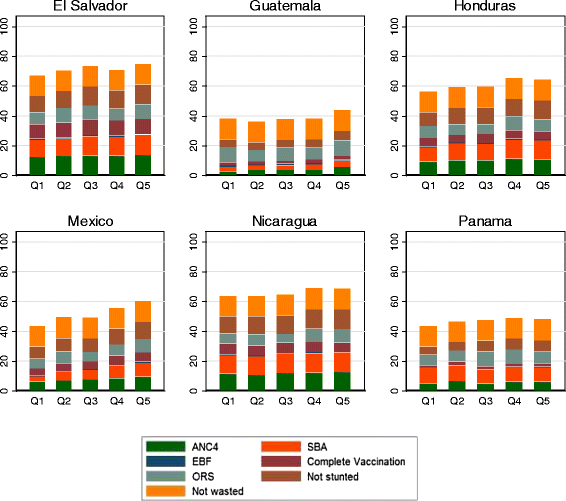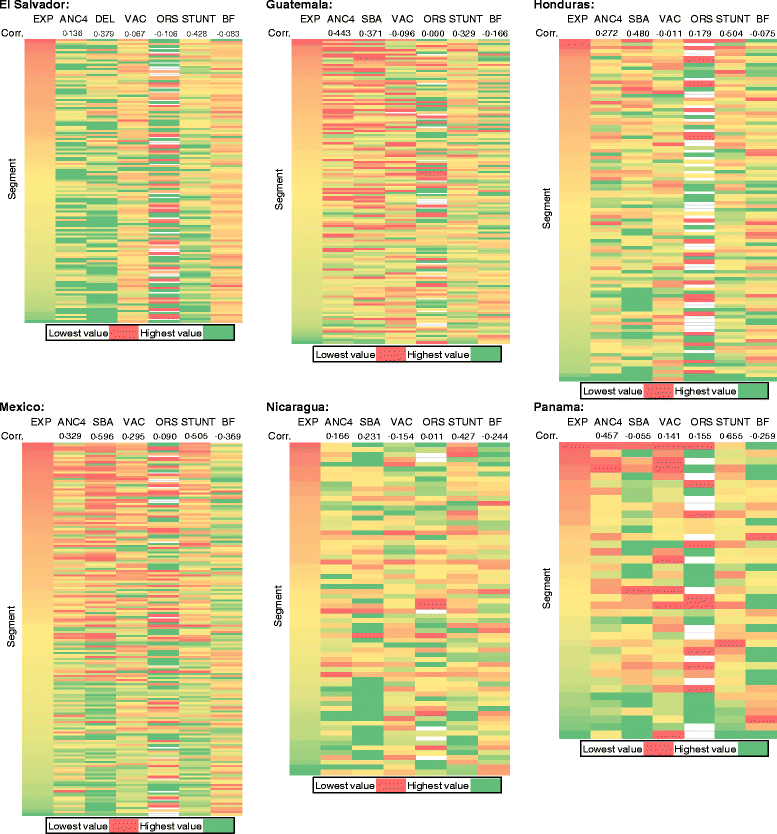Health and wealth in Mesoamerica: findings from Salud Mesomérica 2015
- PMID: 26170012
- PMCID: PMC4501100
- DOI: 10.1186/s12916-015-0393-5
Health and wealth in Mesoamerica: findings from Salud Mesomérica 2015
Abstract
Background: Individual income and poverty are associated with poor health outcomes. The poor face unique challenges related to access, education, financial capacity, environmental effects, and other factors that threaten their health outcomes.
Methods: We examined the variation in the health outcomes and health behaviors among the poorest quintile in eight countries of Mesoamerica using data from the Salud Mesomérica 2015 baseline household surveys. We used multivariable logistic regression to measure the association between delivering a child in a health facility and select household and maternal characteristics, including education and measures of wealth.
Results: Health indicators varied greatly between geographic segments. Controlling for other demographic characteristics, women with at least secondary education were more likely to have an in-facility delivery compared to women who had not attended school (OR: 3.20, 95 % confidence interval [CI]: 2.56-3.99, respectively). Similarly, women from households with the highest expenditure were more likely to deliver in a health facility compared to those from the lowest expenditure households (OR 3.06, 95 % CI: 2.43-3.85). Household assets did not impact these associations. Moreover, we found that commonly-used definitions of poverty do not align with the disparities in health outcomes observed in these communities.
Conclusions: Although poverty measured by expenditure or wealth is associated with health disparities or health outcomes, a composite indicator of health poverty based on coverage is more likely to focus attention on health problems and solutions. Our findings call for the public health community to define poverty by health coverage measures rather than income or wealth. Such a health-poverty metric is more likely to generate attention and mobilize targeted action by the health communities than our current definition of poverty.
Figures



Similar articles
-
Access to environmental health assets across wealth strata: Evidence from 41 low- and middle-income countries.PLoS One. 2018 Nov 16;13(11):e0207339. doi: 10.1371/journal.pone.0207339. eCollection 2018. PLoS One. 2018. PMID: 30444899 Free PMC article.
-
Barriers and facilitators for institutional delivery among poor Mesoamerican women: a cross-sectional study.Health Policy Plan. 2017 Jul 1;32(6):769-780. doi: 10.1093/heapol/czx010. Health Policy Plan. 2017. PMID: 28335004
-
Associations Between Orphan and Vulnerable Child Caregiving, Household Wealth Disparities, and Women's Overweight Status in Three Southern African Countries Participating in Demographic Health Surveys.Matern Child Health J. 2015 Aug;19(8):1662-71. doi: 10.1007/s10995-015-1680-7. Matern Child Health J. 2015. PMID: 25630405 Free PMC article.
-
Using the Demographic Health Survey wealth index to create family planning market segments based on absolute income levels.BMJ Glob Health. 2020 Sep;5(9):e002450. doi: 10.1136/bmjgh-2020-002450. BMJ Glob Health. 2020. PMID: 32928799 Free PMC article. Review.
-
Income and health: the time dimension.Soc Sci Med. 2001 May;52(9):1371-90. doi: 10.1016/s0277-9536(00)00244-6. Soc Sci Med. 2001. PMID: 11286362 Review.
Cited by
-
Antenatal care as a means to increase participation in the continuum of maternal and child healthcare: an analysis of the poorest regions of four Mesoamérican countries.BMC Pregnancy Childbirth. 2019 Feb 12;19(1):66. doi: 10.1186/s12884-019-2207-9. BMC Pregnancy Childbirth. 2019. PMID: 30755183 Free PMC article.
-
Transnational wealth-related health inequality measurement.SSM Popul Health. 2018 Oct 24;6:259-275. doi: 10.1016/j.ssmph.2018.10.009. eCollection 2018 Dec. SSM Popul Health. 2018. PMID: 30426063 Free PMC article.
-
Wealth gradients in healthy aging: evidence from the 2011 and 2013 waves of the China Health and Retirement Longitudinal Study.Arch Public Health. 2025 Feb 21;83(1):47. doi: 10.1186/s13690-025-01526-2. Arch Public Health. 2025. PMID: 39985065 Free PMC article.
References
-
- United Nations. Goal 1: Eradicate Extreme Poverty & Hunger. http://www.un.org/millenniumgoals/poverty.shtml.
-
- The World Bank . World Development Report 2014. Washington, DC: International Bank for Reconstruction and Development / The World Bank; 2013.
Publication types
MeSH terms
LinkOut - more resources
Full Text Sources
Other Literature Sources
Miscellaneous

